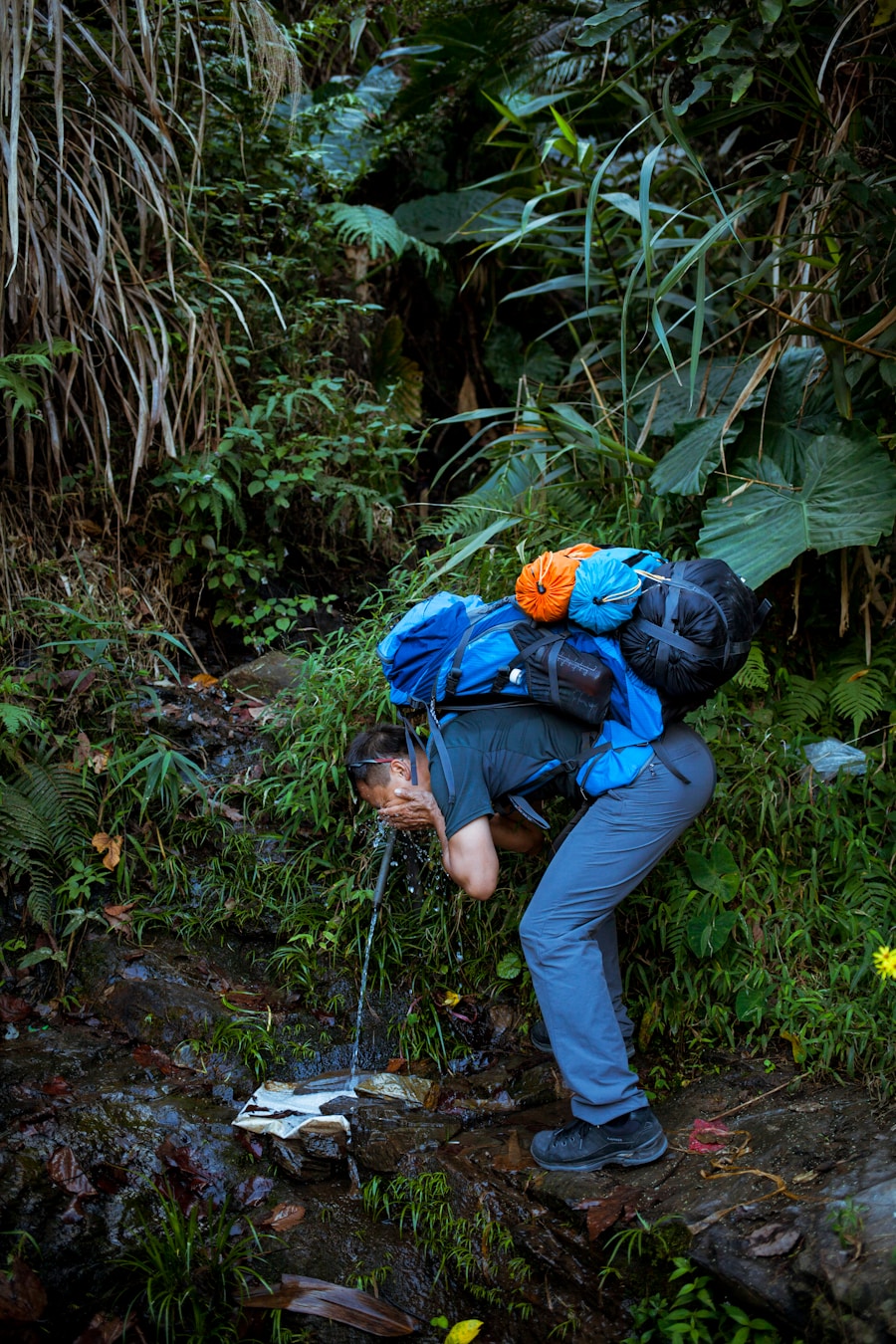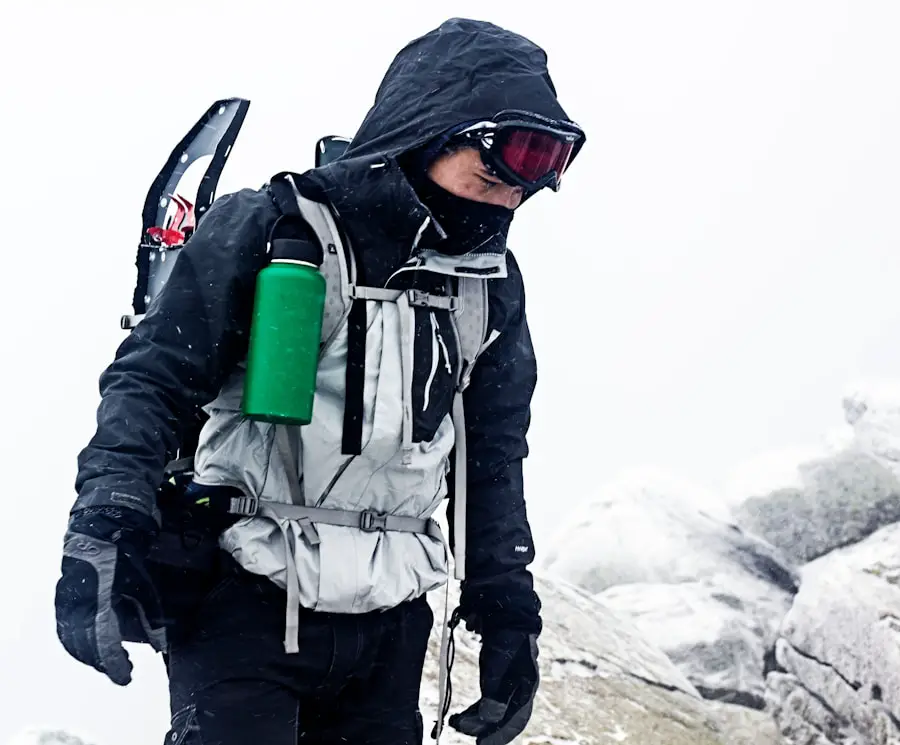Hydration is a critical component of outdoor activities, particularly hiking, where physical exertion and environmental factors can significantly impact the body’s water balance. When hiking, the body loses water through sweat, respiration, and even urination. This loss can lead to dehydration, which can impair physical performance, cognitive function, and overall well-being.
Studies have shown that even a 2% decrease in body weight due to fluid loss can lead to a noticeable decline in endurance and strength. Therefore, maintaining proper hydration is essential not only for comfort but also for safety during hikes. Moreover, the importance of hydration extends beyond just quenching thirst.
Water plays a vital role in regulating body temperature, lubricating joints, and transporting nutrients throughout the body. When hiking in challenging terrains or at high altitudes, the risk of dehydration increases due to higher rates of perspiration and increased respiratory water loss. This makes it imperative for hikers to be proactive about their hydration strategies.
Understanding the signs of dehydration—such as dry mouth, fatigue, dizziness, and dark urine—can help hikers take timely action to replenish fluids and avoid serious health issues.
Key Takeaways
- Proper hydration is crucial for hiking to maintain energy, prevent heat-related illnesses, and optimize performance.
- Consider factors like capacity, material, and ease of use when choosing a water bottle or hydration pack for hiking.
- Distribute water weight evenly in your pack, use a hydration system, and plan for refills to carry water efficiently on hikes.
- Adjust your hydration strategy based on the length, intensity, and environmental conditions of the hike.
- Adapt your hydration plan to account for varying temperatures, humidity, and altitude during different weather conditions.
- Monitor children and pets for signs of dehydration, and plan for their hydration needs during hikes.
- Be aware of symptoms of dehydration, heat exhaustion, and hyponatremia, and take precautions to prevent these health concerns.
- Minimize single-use plastic waste by using reusable water bottles and considering water sources and purification methods for environmental sustainability.
Choosing the Right Water Bottle or Hydration Pack
Selecting the appropriate water container is crucial for ensuring that hikers can stay hydrated throughout their journey. Water bottles come in various materials, including stainless steel, plastic, and glass, each with its own set of advantages and disadvantages. Stainless steel bottles are durable and often insulated, keeping water cold for extended periods.
However, they can be heavier than their plastic counterparts. On the other hand, plastic bottles are lightweight and often more affordable but may not keep water cool for long durations and can retain odors over time. Hydration packs have gained popularity among hikers for their convenience and hands-free design.
These packs typically feature a reservoir that holds water and a tube that allows for easy sipping while on the move. This design encourages regular hydration without the need to stop and fumble with a bottle. When choosing a hydration pack, factors such as capacity, fit, and additional features like pockets for gear should be considered.
A well-fitted hydration pack can distribute weight evenly across the back, reducing strain during long hikes.
Tips for Carrying Water Efficiently

Efficiently carrying water on hikes involves more than just choosing the right container; it also requires strategic planning regarding how much water to bring and how to access it during the hike. A common guideline is to drink about half a liter of water per hour of moderate activity in moderate temperatures. However, this can vary based on individual needs, hike intensity, and environmental conditions.
Therefore, hikers should assess their personal hydration needs and plan accordingly. In addition to quantity, accessibility is key when it comes to staying hydrated on the trail. For those using water bottles, consider attaching them to a belt or using a carabiner to keep them within easy reach.
Hydration packs often come with external pockets that can hold snacks or other essentials while keeping the water reservoir accessible through a tube. It’s also beneficial to establish a routine for drinking water—such as taking sips every 15-20 minutes—to ensure consistent hydration rather than waiting until thirst sets in.
Hydration Strategies for Different Types of Hikes
| Hike Type | Hydration Strategy |
|---|---|
| Day Hike | Carry at least 2 liters of water and drink regularly throughout the hike |
| Overnight Hike | Bring a water filtration system to refill water from natural sources along the trail |
| Mountain Hike | Consume electrolyte drinks to replenish lost minerals due to high altitude and physical exertion |
| Desert Hike | Carry a minimum of 3 liters of water per person and wear sun-protective clothing |
Different types of hikes require tailored hydration strategies based on duration, intensity, and terrain. For short day hikes, carrying a single water bottle or a small hydration pack may suffice. However, for longer treks or multi-day backpacking trips, hikers should consider bringing larger reservoirs or multiple bottles to ensure they have enough water for the entire journey.
Planning routes that include reliable water sources—such as streams or lakes—can also help reduce the amount of water carried initially. In addition to quantity, the timing of hydration is crucial during strenuous hikes. For example, during steep ascents or challenging scrambles, hikers may find it beneficial to take small sips frequently rather than gulping down large amounts at once.
This approach helps prevent sloshing in the stomach and allows for better absorption of fluids. On the other hand, during flat stretches or downhill sections where exertion is lower, hikers might take advantage of these moments to drink more substantial amounts of water.
Staying Hydrated in Different Weather Conditions
Weather conditions play a significant role in hydration needs while hiking. In hot weather, the body loses fluids rapidly through sweat as it works to cool itself down. Hikers should be particularly vigilant about their hydration levels during these conditions, as dehydration can occur quickly.
It’s advisable to drink more frequently and consider electrolyte-replenishing drinks that can help replace lost salts and minerals. Conversely, cold weather presents its own challenges regarding hydration. Many hikers mistakenly believe they need less water in colder temperatures; however, dehydration can still occur due to increased respiratory loss and dry air conditions.
Additionally, when engaging in physical activity in cold weather, the body may require more energy—and thus more hydration—to maintain core temperature. Hikers should ensure they are drinking regularly and may benefit from warm beverages that can provide both hydration and warmth.
Hydration Tips for Hiking with Children or Pets

When hiking with children or pets, special considerations must be made regarding hydration needs. Children are particularly susceptible to dehydration due to their smaller body size and higher metabolic rates compared to adults. Parents should encourage regular drinking breaks and make hydration fun by allowing children to choose their favorite flavored water or using colorful bottles that appeal to them.
It’s also essential to monitor their behavior closely; signs of fatigue or irritability can indicate that they need more fluids. Pets also require careful attention when it comes to hydration on hikes. Dogs can easily become dehydrated, especially during warm weather or strenuous activities.
Hikers should carry portable water bowls or collapsible containers specifically designed for pets to make it easier to provide them with water during breaks. Additionally, it’s important to know your pet’s limits; if they show signs of exhaustion or excessive panting, it may be time to take a break and offer them some water.
Hydration-Related Health and Safety Concerns
Hydration-related health issues can range from mild discomfort to severe medical emergencies if not addressed promptly. Dehydration is one of the most common concerns among hikers; symptoms can escalate from thirst and dry mouth to dizziness, confusion, and even heat exhaustion or heat stroke in extreme cases. Recognizing these symptoms early is crucial for preventing serious health risks associated with dehydration.
Another concern is overhydration or hyponatremia, which occurs when an individual consumes excessive amounts of water without adequate electrolyte intake. This condition dilutes sodium levels in the blood and can lead to symptoms such as nausea, headache, confusion, and in severe cases, seizures or coma. Hikers should aim for a balanced approach by incorporating electrolyte-rich foods or drinks into their hydration strategy—especially during long hikes or in hot weather—to maintain proper sodium levels while staying hydrated.
Environmental Considerations for Hydration on Hikes
As outdoor enthusiasts become increasingly aware of their environmental impact, it’s essential to consider sustainable practices related to hydration while hiking. One significant aspect is the choice between single-use plastic bottles and reusable containers. Opting for reusable bottles not only reduces waste but also encourages hikers to be more mindful about their consumption habits.
Additionally, when sourcing water from natural bodies during hikes—such as streams or lakes—hikers must prioritize environmental stewardship by ensuring they do not contaminate these sources. Using portable water filters or purification tablets can help make natural water safe for consumption while minimizing ecological disruption. It’s also important to follow Leave No Trace principles by packing out all waste and being respectful of wildlife habitats when accessing water sources along trails.
By understanding the importance of hydration on hikes and implementing effective strategies tailored to individual needs and environmental conditions, hikers can enhance their outdoor experiences while prioritizing health and safety.
When going on a hiking trip, it is essential to stay hydrated throughout the journey. One way to ensure you have enough water is by carrying a reliable water bottle or hydration pack. However, if you are looking for a more compact and convenient option, you may want to consider using a collapsible water bottle. These bottles are lightweight and can easily be stored in your backpack when not in use. For more tips on essential gear for hiking, check out this article on solar-powered camping lanterns to help you navigate through the wilderness safely.
FAQs
What are the best ways to carry water while hiking?
There are several options for carrying water while hiking, including hydration packs, water bottles, collapsible water bottles, and hydration belts.
What is a hydration pack and how does it work?
A hydration pack is a backpack with a built-in water reservoir and a drinking tube. The reservoir is filled with water and the tube allows the hiker to drink hands-free while on the move.
What are the advantages of using a hydration pack?
Hydration packs allow for hands-free drinking, which is convenient while hiking. They also distribute the weight of the water evenly on the hiker’s back, making it more comfortable to carry.
What are the disadvantages of using a hydration pack?
Hydration packs can be more difficult to clean and may be more prone to developing mold if not properly maintained. They also have a limited capacity compared to some other water-carrying options.
What should I consider when choosing a water-carrying method for hiking?
When choosing a water-carrying method for hiking, consider factors such as the length of the hike, the availability of water sources along the trail, the weather conditions, and personal preferences for convenience and comfort.
How much water should I carry while hiking?
The amount of water to carry while hiking depends on factors such as the length and intensity of the hike, the weather conditions, and the availability of water sources along the trail. As a general guideline, it’s recommended to carry at least 0.5 to 1 liter of water per hour of hiking.
What are some tips for staying hydrated while hiking?
Some tips for staying hydrated while hiking include drinking water regularly, even if you don’t feel thirsty, and consuming electrolyte-rich drinks or snacks to replenish lost minerals through sweating. It’s also important to monitor your urine color, as dark yellow urine can be a sign of dehydration.
